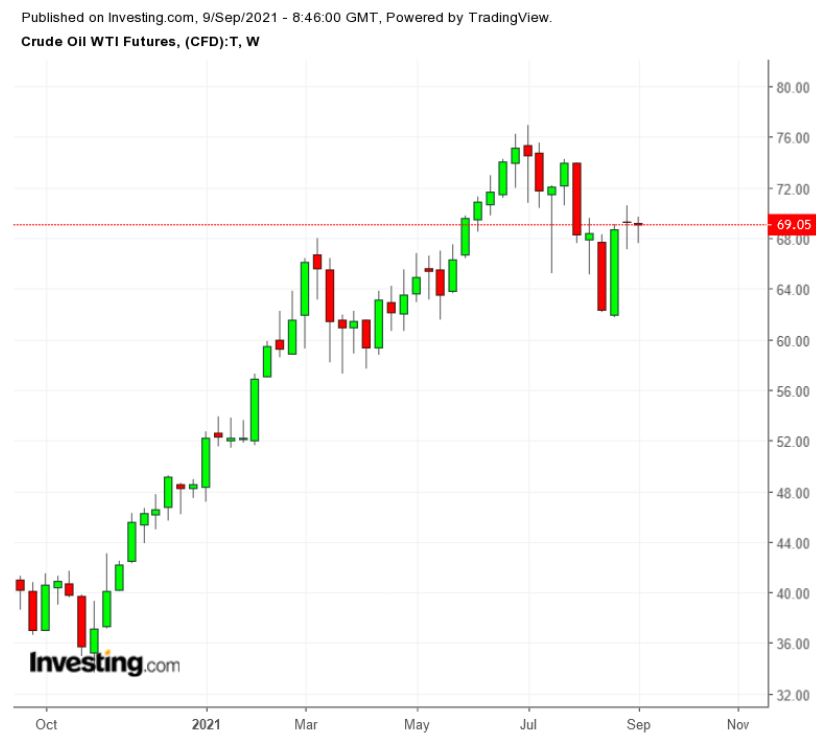In the past two weeks, two very different outlooks on the oil market were released.
The first, from OPEC, presents a cautious look at the supply and demand picture for 2022. The second, from Morgan Stanley, depicts a more positive view of global demand along with limited supply but relies on many questionable assumptions.

Below, an analysis of both outlooks and what traders should consider regarding what each could mean for crude oil prices.
1. OPEC: Cautious Demand and Supply Scenario
OPEC+ met virtually last week and, after less than an hour of discussion, decided to reaffirm its existing plan to raise oil production by 400,000 bpd in October. In July, the group agreed on a long-term production scheme in which OPEC+ will increase production by 400,000 bpd each month through September 2022.
However, because the group also plans to continue meeting every month, it will assess market conditions and may decide to change its plans based on current conditions or new forecasts.
At its September meeting, OPEC+ ministers considered new oil market forecasts. The forecast for 2021 was not made public, but, according to sources at the meeting, it indicates that the commercial oil inventories in the OECD (a group of economically developed countries) are anticipated to remain below the 2015-2019 average until May 2022.
However, after this point, OECD oil inventories are expected to grow and could reach peak levels by the end of 2022. This forecast assumes that global oil demand returns to pre-pandemic levels of approximately 100 million bpd.
OPEC also presented a second scenario, which assumes that global oil demand does not return to pre-pandemic levels in 2022 and instead remains 2 million bpd lower. In this scenario, commercial oil inventories are expected to rise even more and will hit peak levels sooner.
The takeaway for traders is that if demand falls short of pre-pandemic levels for any reason (coronavirus surge, inflation, economic recessions) and OPEC+ continues increasing production as planned, we could see a steep rise in commercial oil inventories in 2022.
This would also cause oil prices to fall. OPEC+ may be able to adjust and scale back its supply increases, but as we have seen in the past, the group is prone to discord and might increase production regardless of global demand signals.
2. Morgan Stanley: Optimistic Demand and Lower Supply Scenario
In contrast to OPEC+, Morgan Stanley recently issued a very optimistic forecast of expected oil market conditions. The bank is much less concerned about oil inventories growing in 2022. Its analysts believe that exploration and production (E&P) companies in the United States will continue to exercise “capital discipline” and won’t increase production.
They also believe that OPEC+ will adjust its production plans to prevent commercial oil inventories from rising too high. Relying on analysis from Morgan Stanley’s Biotech division, oil analysts also believe that the current wave of coronavirus infections, which they attribute to the Delta variant, will subside in September and that U.S. gasoline demand will increase.
Analysts at Morgan Stanley also believe demand in China will act similarly. Therefore they don’t see any reason why oil demand might not hit pre-pandemic levels.
This analysis relies on many assumptions, each of which must happen as predicted for demand to grow and supply not to outpace it. Traders should be cautious about relying on a forecast that counts on too many assumptions that could easily go the other way.
For example, OPEC+ could easily find itself in a situation in which some members want to ease supply increases (Saudi Arabia, for example) while others do not (the UAE and Iraq, for example). This could result in an impasse such as what we saw earlier this summer.
In the United States, oil companies aren’t expanding like they used to, but oil production is increasing. At the end of August, production was up to 11.5 million bpd. This reflects an increase of 500,000 bpd from the beginning of June.
As the Biden administration eases its moratorium on drilling leases on federal land, it is possible more E&P companies will be interested in drilling.
When it comes to the coronavirus, Morgan Stanley’s forecast seems particularly suspect, especially as it relates to gasoline demand. Yes, the coronavirus wave in the southern U.S. seems to be abating, but it's unclear why Morgan Stanley does not believe that the northeast and Midwest regions won’t see a similar surge in the fall and winter (like they did last year following the south’s summertime surge).
According to GasBuddy, Florida and Texas did not see any noticeable drop in demand during the coronavirus spikes this summer. However, the northeastern parts of the United States are more likely to see government and business intervention that would shut down or decrease movement in the event of a local wave of cases.
